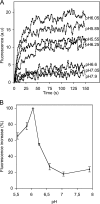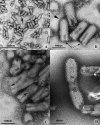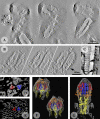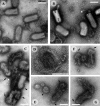Distinct structural rearrangements of the VSV glycoprotein drive membrane fusion
- PMID: 20921141
- PMCID: PMC2953448
- DOI: 10.1083/jcb.201006116
Distinct structural rearrangements of the VSV glycoprotein drive membrane fusion
Abstract
The entry of enveloped viruses into cells requires the fusion of viral and cellular membranes, driven by conformational changes in viral glycoproteins. Many studies have shown that fusion involves the cooperative action of a large number of these glycoproteins, but the underlying mechanisms are unknown. We used electron microscopy and tomography to study the low pH-induced fusion reaction catalyzed by vesicular stomatitis virus glycoprotein (G). Pre- and post-fusion crystal structures were observed on virions at high and low pH, respectively. Individual fusion events with liposomes were also visualized. Fusion appears to be driven by two successive structural rearrangements of G at different sites on the virion. Fusion is initiated at the flat base of the particle. Glycoproteins located outside the contact zone between virions and liposomes then reorganize into regular arrays. We suggest that the formation of these arrays, which have been shown to be an intrinsic property of the G ectodomain, induces membrane constraints, achieving the fusion reaction.
Figures








Similar articles
-
Attenuation of recombinant vesicular stomatitis viruses encoding mutant glycoproteins demonstrate a critical role for maintaining a high pH threshold for membrane fusion in viral fitness.Virology. 1998 Jan 20;240(2):349-58. doi: 10.1006/viro.1997.8921. Virology. 1998. PMID: 9454708
-
The membrane-proximal domain of vesicular stomatitis virus G protein functions as a membrane fusion potentiator and can induce hemifusion.J Virol. 2002 Dec;76(23):12300-11. doi: 10.1128/jvi.76.23.12300-12311.2002. J Virol. 2002. PMID: 12414970 Free PMC article.
-
Mechanism of membrane fusion induced by vesicular stomatitis virus G protein.Proc Natl Acad Sci U S A. 2017 Jan 3;114(1):E28-E36. doi: 10.1073/pnas.1618883114. Epub 2016 Dec 14. Proc Natl Acad Sci U S A. 2017. PMID: 27974607 Free PMC article.
-
Structures of vesicular stomatitis virus glycoprotein: membrane fusion revisited.Cell Mol Life Sci. 2008 Jun;65(11):1716-28. doi: 10.1007/s00018-008-7534-3. Cell Mol Life Sci. 2008. PMID: 18345480 Free PMC article. Review.
-
Viral inactivation based on inhibition of membrane fusion: understanding the role of histidine protonation to develop new viral vaccines.Protein Pept Lett. 2009;16(7):779-85. doi: 10.2174/092986609788681823. Protein Pept Lett. 2009. PMID: 19601907 Review.
Cited by
-
A Pseudovirus-Based Entry Assay to Evaluate Neutralizing Activity against Respiratory Syncytial Virus.Viruses. 2023 Jul 14;15(7):1548. doi: 10.3390/v15071548. Viruses. 2023. PMID: 37515234 Free PMC article.
-
Monomeric Intermediates Formed by Vesiculovirus Glycoprotein during Its Low-pH-induced Structural Transition.J Mol Biol. 2018 Jun 8;430(12):1685-1695. doi: 10.1016/j.jmb.2018.04.015. Epub 2018 Apr 18. J Mol Biol. 2018. PMID: 29678555 Free PMC article. Review.
-
Improving promiscuous mammalian cell entry by the baculovirus Autographa californica multiple nuclear polyhedrosis virus.Biosci Rep. 2012 Nov 30;33(1):23-36. doi: 10.1042/BSR20120093. Biosci Rep. 2012. PMID: 23035899 Free PMC article.
-
Multi-virion infectious units arise from free viral particles in an enveloped virus.Nat Microbiol. 2017 May 22;2:17078. doi: 10.1038/nmicrobiol.2017.78. Nat Microbiol. 2017. PMID: 28530650 Free PMC article.
-
Immunovirotherapy Based on Recombinant Vesicular Stomatitis Virus: Where Are We?Front Immunol. 2022 Jun 28;13:898631. doi: 10.3389/fimmu.2022.898631. eCollection 2022. Front Immunol. 2022. PMID: 35837384 Free PMC article. Review.
References
-
- Brown J.C., Newcomb W.W., Lawrenz-Smith S. 1988. pH-dependent accumulation of the vesicular stomatitis virus glycoprotein at the ends of intact virions. Virology. 167:625–629 - PubMed
Publication types
MeSH terms
Substances
LinkOut - more resources
Full Text Sources

